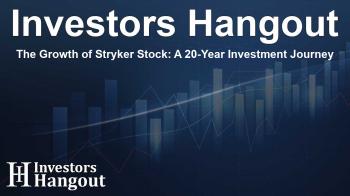The Growth of Stryker Stock: A 20-Year Investment Journey

Exploring Stryker's Stock Growth Over Two Decades
Stryker (SYK) has significantly outperformed the market over the past 20 years, boasting an annualized return that exceeds the average by 2.09%. This remarkable performance results in an impressive average annual growth rate of 10.48%. Today, Stryker stands tall with a robust market capitalization of approximately $137.65 billion.
Understanding the Investment Potential
Imagine if an investor had chosen to invest $100 in Stryker stock two decades ago. Today, that initial investment would have grown to $730.67. This figure is based on the current stock price of $361.08 for SYK, showcasing the incredible potential of long-term investments in sound companies.
Evaluating Stryker's Historical Performance
A critical understanding emerges when evaluating Stryker's historical stock performance. Investors learn that despite market fluctuations, the power of compound returns can significantly enhance wealth creation over time. Holding onto quality stocks like Stryker demonstrates the importance of patience in investment strategies.
The Importance of Compound Growth
What does this data illustrate about investing? The transformative effect of compounded returns is profound, highlighting how an initial investment can grow substantially when given time and market support. In the case of Stryker, the long-term investor has seen their cash grow significantly, making a compelling case for sustained investment in the company.
Conclusion
In conclusion, Stryker's performance over the past 20 years serves as a testament to the efficacy of long-term investing strategies. As stock prices increase and market conditions fluctuate, the past two decades reveal that maintaining a stake in strong companies can yield remarkable returns. Therefore, for investors considering their options, Stryker's growth story is one worth noting and potentially emulating.
Frequently Asked Questions
What has been Stryker's annualized return over the last 20 years?
Stryker has achieved an annualized return of 10.48% over the past 20 years, outperforming the market by 2.09%.
If I invested $100 in Stryker 20 years ago, what would it be worth today?
An investment of $100 in Stryker stock made 20 years ago would be worth approximately $730.67 today.
What is Stryker's current market capitalization?
Stryker currently has a market capitalization of about $137.65 billion.
Why is compound growth important in investing?
Compound growth is crucial as it indicates how an investment can significantly increase in value over time through reinvestment of returns.
What can investors learn from Stryker's performance?
Investors can learn the value of long-term commitment to quality stocks, as demonstrated by Stryker's consistent growth over two decades.
About The Author
Contact Evelyn Baker privately here. Or send an email with ATTN: Evelyn Baker as the subject to contact@investorshangout.com.
About Investors Hangout
Investors Hangout is a leading online stock forum for financial discussion and learning, offering a wide range of free tools and resources. It draws in traders of all levels, who exchange market knowledge, investigate trading tactics, and keep an eye on industry developments in real time. Featuring financial articles, stock message boards, quotes, charts, company profiles, and live news updates. Through cooperative learning and a wealth of informational resources, it helps users from novices creating their first portfolios to experts honing their techniques. Join Investors Hangout today: https://investorshangout.com/
The content of this article is based on factual, publicly available information and does not represent legal, financial, or investment advice. Investors Hangout does not offer financial advice, and the author is not a licensed financial advisor. Consult a qualified advisor before making any financial or investment decisions based on this article. This article should not be considered advice to purchase, sell, or hold any securities or other investments. If any of the material provided here is inaccurate, please contact us for corrections.

